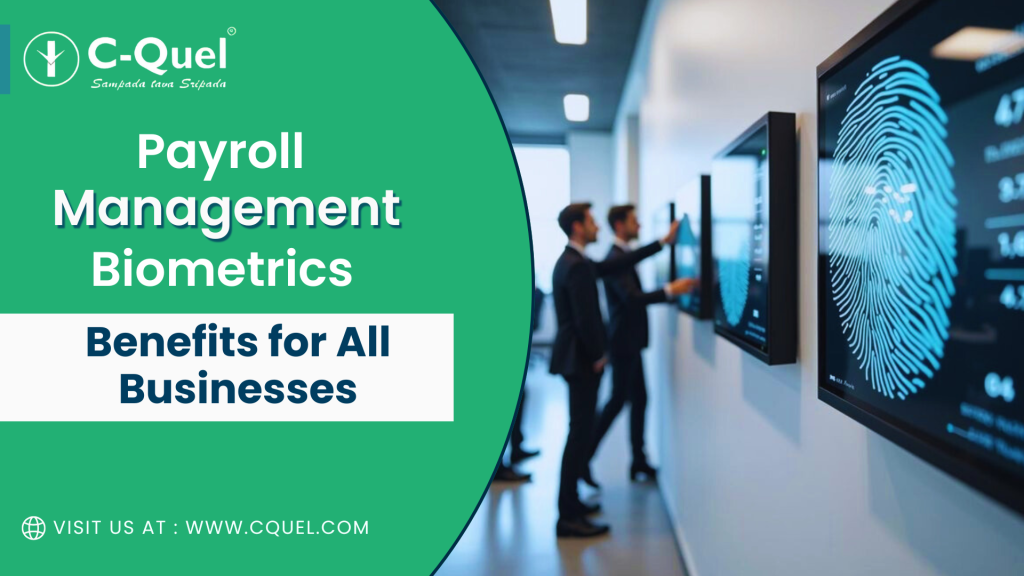Managing payroll can be challenging for any business, whether it’s small or large. It involves not just paying employees on time but also ensuring accuracy, preventing fraud, and keeping clear records. Recently, biometrics payroll management systems have become popular, offering a secure and efficient way to handle payroll tasks.
Let’s get into what biometrics payroll management is, how it works, and the key benefits it offers for both small and large businesses.
What is Biometrics Payroll Management?
Biometrics payroll management uses unique physical traits, such as fingerprints or facial recognition, to track employee attendance and calculate their pay. This method replaces traditional methods like punch cards and manual time entries, reducing errors and improving efficiency.
Biometric systems rely on individual characteristics, making it a secure way to monitor employee attendance and streamline payroll operations.
How Does a Biometrics Payroll System Work?
A biometrics payroll system combines biometric technology with payroll software. Here’s how it typically functions:
- Employee Registration: Employees register with their biometric data, such as a fingerprint scan or facial recognition.
- Tracking Attendance: When employees arrive or leave, they authenticate their presence using their biometric data. The system automatically records this information.
- Calculating Hours: The system tracks the hours worked, including breaks and overtime, using the attendance data.
- Payroll Processing: At the end of the pay period, the system calculates wages based on the tracked hours.
By automating attendance and payroll, businesses can reduce manual work and ensure accurate payment for hours worked.
Benefits of Biometrics Payroll Management for Businesses
Biometrics payroll systems provide several advantages, regardless of business size. Here are the main benefits:
1. Enhanced Accuracy
Mistakes often occur when calculating employee attendance and hours manually. These errors can lead to payroll issues and employee dissatisfaction. Biometrics payroll systems reduce errors by automating the process.
With accurate attendance tracking, there’s no chance of misreporting, ensuring reliable data for payroll calculations.
2. Prevention of Time Theft
Time theft, such as buddy punching (one employee clocking in for another), can cost businesses significantly. Biometric systems prevent these issues by ensuring that only registered employees can clock in or out.
This means only the actual employee can record their attendance, making time theft impossible.
3. Improved Security
Traditional payroll systems can be vulnerable to theft or misuse. Biometrics provide a higher level of security because they use unique physical traits that can’t be lost or stolen.
This system protects businesses from fraud and ensures that employee data is secure and compliant with data protection regulations.
4. Efficient Payroll Processing
By automating attendance tracking and integrating it with payroll software, businesses can save time and effort. Payroll administrators no longer have to manually input or verify hours, which is especially helpful for large companies.
For small businesses, a biometric payroll system simplifies payroll tasks, allowing owners to focus on other important aspects of their business.
5. Scalability
Biometrics payroll systems are scalable, making them suitable for both small businesses and large enterprises. As a business grows, the system can easily accommodate more employees without any major changes.
Investing in a biometric payroll system may seem significant for small businesses, but it pays off by reducing errors and increasing efficiency. Large businesses also benefit from the system’s ability to manage vast amounts of data easily.
6. Compliance and Record-Keeping
Keeping accurate records is vital for complying with labor laws and tax regulations. A biometric payroll system maintains a detailed log of attendance data, ensuring that records are current and accurate.
This simplifies compliance with laws regarding overtime, minimum wage, and employee rights. In case of disputes, businesses can present clear records.
7. Cost-Effective in the Long Run
Although setting up a biometric payroll system requires an initial investment, the long-term benefits outweigh the costs. By reducing errors, preventing time theft, and streamlining payroll, businesses can save on expenses.
The system also minimizes the risk of overpaying employees due to inaccuracies or fraud, resulting in significant cost savings over time.
Why Biometrics Payroll Systems Work for Both Small and Large Businesses
Biometrics payroll management suits businesses of all sizes. Small businesses can greatly benefit from the efficiency and accuracy these systems offer. They save time on administrative tasks, allowing owners to concentrate on growing their businesses.
For large companies, managing a big workforce can be complex, and biometrics provide a seamless solution. The system can scale to handle large amounts of attendance and payroll data without sacrificing efficiency.
In today’s fast-paced business environment, companies need effective systems for managing payroll. Biometrics payroll management offers greater accuracy, fraud prevention, improved security, and time savings for both small and large businesses. By automating attendance tracking and payroll processing, companies can focus on growth rather than administrative tasks.
If you are considering a secure and cost-effective payroll solution, biometrics could be the answer. Additionally, C-Quel provides services to help businesses implement and manage biometric payroll systems, ensuring smooth operations and peace of mind for employers.

